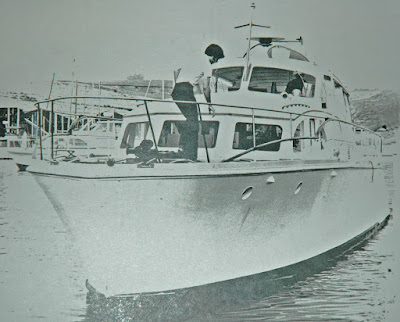The entire “Fuentes/Shooting Star” saga can be found here.
Nine days ago, I posted about the mysterious 1974 sinking of the yacht "Shooting Star," a tragedy that took the life of Tom Fuentes' then-boss, OC Supervisor Ronald Caspers, and nine others. Since then, I've received two articles in the mail, entitled "The Last Voyage of the Shooting Star" (parts 1 and 2), by Wayne Clark.* They're from the November and December, 1974, issues of the now-defunct Orange County Illustrated.
They were sent to me by the daughter of one of the ten victims (one of the three Klein brothers on the yacht).
I'm working my way through these articles, piecing together the curious events in this tragedy. Here's what I've got so far:
THE COAST GUARD ARRIVES FOUR HOURS AFTER SS's MAYDAY. With the information that the SS is near San Benito Island, a Coast Guard helicopter in San Diego heads south at 12:55 a.m. (June 14). A Coast Guard C130 aircraft leaves San Francisco at 1:40 a.m. The helicopter arrives at San Benito Island at 3:45 a.m. and begins the search in a 15-mile radius around the island. The C130 arrives at 4:15 a.m. Each aircraft scans the dark for flares. Their crew spot nothing.
Dawn arrives at about 5:00 a.m. Running low on fuel, the two aircraft and their ten crewmen fly east to the city of Guerrero Negro, where they await refueling—perhaps a tragic delay—while international red tape is untied.
PERMISSION DELAY. The Coast Guard in San Diego can't send out more planes until it gets permission from the Mexican government, but the needed Mexican officials are not available. After 8 hours, officials are located and the permission is granted. A second C130 is dispatched and lands at Guerrero Negro at 1:00 p.m. It refuels the helicopter, and then the two craft head west to San Benitos Island. (The other C130 flies back to San Diego for refueling.) The U.S. and Mexican Navies are contacted to join in the search, but they have no ships in the area. Also, as it happens, few private ships are present.
*Oddly, Clark seems to have been a deputy of one of the OC Supervisors about the time of Caspers death. I haven't yet determined which Supervisor.
 |
| Tim Klein on the "Shooting Star," La Paz |
They were sent to me by the daughter of one of the ten victims (one of the three Klein brothers on the yacht).
I'm working my way through these articles, piecing together the curious events in this tragedy. Here's what I've got so far:
PLANE TO LA PAZ. On Sunday, June 9, 1974, Caspers & Harber's party fly south from LAX to La Paz. From there, they take a charter flight to Cabo. They leave Cabo on the Shooting Star (SS) early the next morning (Monday, the 10th).
Caspers' chief aid, Tom Fuentes, has packed an extra ice chest with steaks, hors d'oeuvres, drinks, etc. (Fuentes was supposed to join the group for the trip, but, at the last minute, he decides not to go.)
ROUGH SEAS. Early into the voyage, the SS runs into rough seas. There are 6 to 8 foot seas for three days and three nights. Only Caspers and Harber are experienced sailors.
At 8:30 a.m. on June 13, the SS gives its position (to an operator in California) as northwest of Turtle Bay (see maps). That it is so far out to sea suggests that it is taking a beeline course to San Diego. The SS calls the National Weather Service to learn of weather conditions in San Diego (they are reported as fair). The forecaster detects no anxiety on the part of the SS crew during the call.
BACK TO TURTLE BAY. The SS next heads southeast (!) to Turtle Bay for refueling. It arrives late in the morning; the refueling takes two hours. Crewmen Joseph Klein, Leonard Bashor, and Richard Tully mail postcards on which they describe the trip as difficult. A dockworker later recalls that the SS's crew was in a "big hurry."
Dawn arrives at about 5:00 a.m. Running low on fuel, the two aircraft and their ten crewmen fly east to the city of Guerrero Negro, where they await refueling—perhaps a tragic delay—while international red tape is untied.
 |
| The Venturous |
Early Friday afternoon, the cutter Venturous is dispatched to the area to organize the search. The ship and its crew of 63 arrive at San Benitos Island at 10:00 a.m., Saturday (the 15th).
LOOKING FOR THE TWO 13-FOOTERS. By Saturday, things look pretty grim, for hypothermia would take any survivors in the water within 24 hours (and, further, sharks are numerous in these waters). And so the search turns to efforts to locate the two boats carried by the SS: a 13-foot Boston whaler and a 13-foot snark sailboat.
On Saturday, another helicopter, three more C130s, and a Navy P2V aircraft (with highly sensitive equipment) arrive in the search zone. Wind and current are taken into account, and thus the search moves southward. But nothing is found. The search area is expanded.
On Sunday, the cabin top of the Shooting Star is spotted, but its location is north of the original search area by some 50 miles! Aircraft head north and continue searching.
They find nothing. Search commences, too, along the Baja coast, on the assumption that the 13-footers would head east, but nothing is found.
*** to be continued***
 |
| A Coast Guard C130 |
 |
| A Navy P2V |










